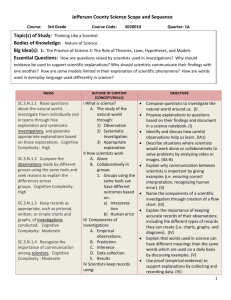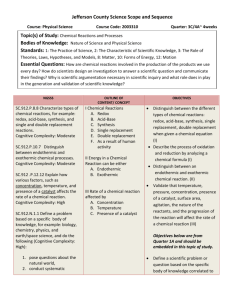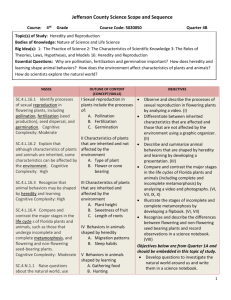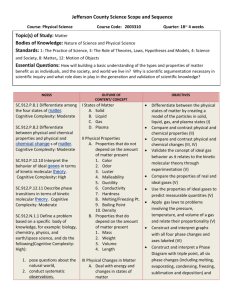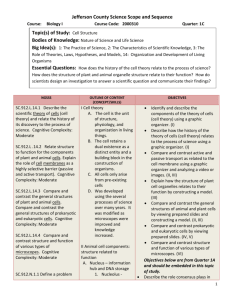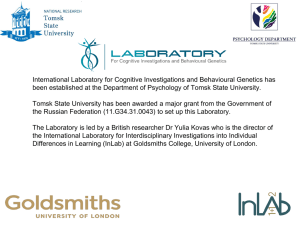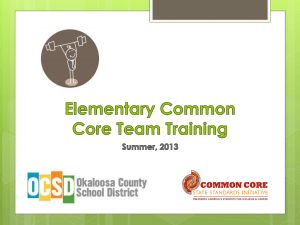Topic 1: Thinking Like a Scientist
advertisement
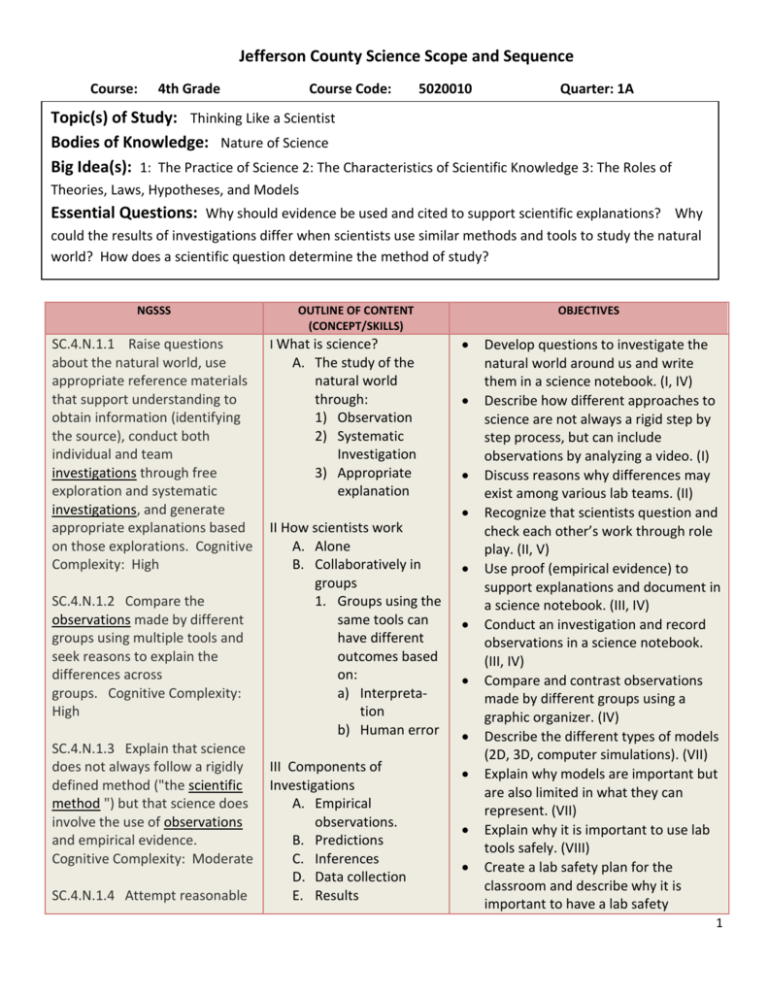
Jefferson County Science Scope and Sequence Course: 4th Grade Course Code: 5020010 Quarter: 1A Topic(s) of Study: Thinking Like a Scientist Bodies of Knowledge: Nature of Science Big Idea(s): 1: The Practice of Science 2: The Characteristics of Scientific Knowledge 3: The Roles of Theories, Laws, Hypotheses, and Models Essential Questions: Why should evidence be used and cited to support scientific explanations? Why could the results of investigations differ when scientists use similar methods and tools to study the natural world? How does a scientific question determine the method of study? NGSSS SC.4.N.1.1 Raise questions about the natural world, use appropriate reference materials that support understanding to obtain information (identifying the source), conduct both individual and team investigations through free exploration and systematic investigations, and generate appropriate explanations based on those explorations. Cognitive Complexity: High SC.4.N.1.2 Compare the observations made by different groups using multiple tools and seek reasons to explain the differences across groups. Cognitive Complexity: High SC.4.N.1.3 Explain that science does not always follow a rigidly defined method ("the scientific method ") but that science does involve the use of observations and empirical evidence. Cognitive Complexity: Moderate SC.4.N.1.4 Attempt reasonable OUTLINE OF CONTENT (CONCEPT/SKILLS) I What is science? A. The study of the natural world through: 1) Observation 2) Systematic Investigation 3) Appropriate explanation OBJECTIVES II How scientists work A. Alone B. Collaboratively in groups 1. Groups using the same tools can have different outcomes based on: a) Interpretation b) Human error III Components of Investigations A. Empirical observations. B. Predictions C. Inferences D. Data collection E. Results Develop questions to investigate the natural world around us and write them in a science notebook. (I, IV) Describe how different approaches to science are not always a rigid step by step process, but can include observations by analyzing a video. (I) Discuss reasons why differences may exist among various lab teams. (II) Recognize that scientists question and check each other’s work through role play. (II, V) Use proof (empirical evidence) to support explanations and document in a science notebook. (III, IV) Conduct an investigation and record observations in a science notebook. (III, IV) Compare and contrast observations made by different groups using a graphic organizer. (IV) Describe the different types of models (2D, 3D, computer simulations). (VII) Explain why models are important but are also limited in what they can represent. (VII) Explain why it is important to use lab tools safely. (VIII) Create a lab safety plan for the classroom and describe why it is important to have a lab safety 1 Jefferson County Science Scope and Sequence answers to scientific questions and cite evidence in support. Cognitive Complexity: High SC.4.N.1.5 Compare the methods and results of investigations done by other classmates. Cognitive Complexity :Moderate SC.4.N.1.6 Keep records that describe observations made, carefully distinguishing actual observations from ideas and inferences about the observations. Cognitive Complexity: High SC.4.N.1.7 Recognize and explain that scientists base their explanations on evidence. Cognitive Complexity: Moderate SC.4.N.1.8 Recognize that science involves creativity in designing experiments. Cognitive Complexity: Moderate SC.4.N.2.1 Explain that science focuses solely on the natural world. Cognitive Complexity: Moderate IV Scientists keep records using; A. Pictures B. Graphic organizers C. Graphs D. Charts E. Written explanations contract. (VIII) Work together in groups to complete a model science board, illustrating the components of a scientific investigation. (IX) V Scientists communicate to; A. Share findings B. Check the accuracy of one another’s work C. Debate explanations D. Share inferences based on observations VI Empirical Evidence can validate explanations of natural phenomena A. Observations B. Measurements VII The use of models A. Visual representations B. Types of models – 1 dimensional, 2 and 3 dimensional C. Computer models D. Mental explanation SC.4.N.3.1 Explain that models can be three dimensional, two dimensional, an explanation in your mind, or a computer model. Cognitive Complexity: Moderate VIII Using scientific tools and working safely A. Lab Tools 1. Used by scientists to carry out investigations MACC.4.MD.1.1: Know relative sizes 2. TEACHER NOTE: of measurement units within one show examples 2 Jefferson County Science Scope and Sequence system of units including km, m, cm; kg, g; lb, oz.; l, ml; hr, min, sec. Within a single system of measurement, express measurements in a larger unit in terms of a smaller unit. Record measurement equivalents in a two column table. For example, know that 1 ft is 12 times as long as 1 in. Express the length of a 4 ft snake as 48 in. Generate a conversion table for feet and inches listing the number pairs (1, 12), (2, 24), (3, 36), ... MACC.4.MD.2.4: Make a line plot to display a data set of measurements in fractions of a unit (1/2, 1/4, 1/8). Solve problems involving addition and subtraction of fractions by using information presented in line plots. For example, from a line plot find and interpret the difference in length between the longest and shortest specimens in an insect collection. LACC.4.RI.1.3: Explain events, procedures, ideas, or concepts in a historical, scientific, or technical text, including what happened and why, based on specific information in the text. LACC.4.RI.2.4: Explain events, procedures, ideas, or concepts in a historical, scientific, or technical text, including what happened and why, based on specific information in the text. LACC.4.RI.2.4: Determine the meaning of general academic and domain-specific words or phrases in a text relevant to a grade 4 topic or subject area. LACC.4.RI.4.10: By the end of year, of lab tools and explain their use. B. Lab Safety 1. TEACHER NOTE: download and refer to safety contract on resource page 2. Identify and discuss lab safety tools in classrooms 3. Lab Safety Plan (refer to objective) IX How to do a science project A. Experimental Design 1. Ask a question 2. Plan investigation a) Identify independent variable (what is being tested) b) Determine the dependent variable (how it will be measured) c) Identify constants (parts of the investigation that must remain the same) d) Ensure that one group remains untouched 3 Jefferson County Science Scope and Sequence read and comprehend informational texts, including history/social studies, science, and technical texts, in the grades 4–5 text complexity band proficiently, with scaffolding as needed at the high end of the range. LACC.4.SL.1.1: Engage effectively in a range of collaborative discussions (one-on-one, in groups, and teacher-led) with diverse partners on grade 4 topics and texts, building on others’ ideas and expressing their own clearly. a. Come to discussions prepared, having read or studied required material; explicitly draw on that preparation and other information known about the topic to explore ideas under discussion. b. Follow agreed-upon rules for discussions and carry out assigned roles. c. Pose and respond to specific questions to clarify or follow up on information, and make comments that contribute to the discussion and link to the remarks of others. d. Review the key ideas expressed and explain their own ideas and understanding in light of the discussion. LACC.4.W.3.8: Recall relevant information from experiences or gather relevant information from print and digital sources; take notes and categorize information, and provide a list of sources. LACC.4.W.3.9: Draw evidence from literary or informational texts to support analysis, reflection, and research. a. Apply grade 4 Reading standards to literature (e.g., “Describe in depth a character, for comparison – the control group 3. Research background information on topic a) Address appropriate research materials b) Address how to cite sources accurately c) Address plagiarism 4. Collect and record data a) Graphs b) Charts c) Visual representations 5. Share findings a) Draw conclusions using data b) Uses repeated trials c) Ask new questions and develop new investigations B. TEACHER NOTE: Refer to ISEF (International Science and Engineering Fair) forms on resource page. 4 Jefferson County Science Scope and Sequence setting, or event in a story or drama, drawing on specific details in the text [e.g., a character’s thoughts, words, or actions].”). b. Apply grade 4 Reading standards to informational texts (e.g., “Explain how an author uses reasons and evidence to support particular points in a text”). TEACHER TRANSITION INTO NEXT TOPIC OF STUDY Now that we know that we can study the natural world through observations, investigations and explanations, let’s use these skills to help us understand the patterns in the sky and the relationship between the Sun, Earth, and Moon. 5
